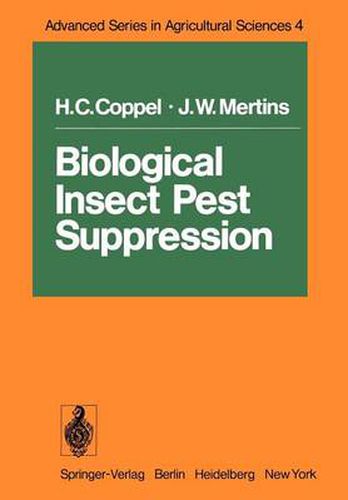Readings Newsletter
Become a Readings Member to make your shopping experience even easier.
Sign in or sign up for free!
You’re not far away from qualifying for FREE standard shipping within Australia
You’ve qualified for FREE standard shipping within Australia
The cart is loading…






This title is printed to order. This book may have been self-published. If so, we cannot guarantee the quality of the content. In the main most books will have gone through the editing process however some may not. We therefore suggest that you be aware of this before ordering this book. If in doubt check either the author or publisher’s details as we are unable to accept any returns unless they are faulty. Please contact us if you have any questions.
The subject area embraced by the term biological control in its classical sense is very broad indeed. The term itself was apparently first used in 1919 by the late Harry S. Smith, and was then used specifically in reference to the suppression of insect populations by the actions of their indigenous or introduced natural enemies. The California school of biological control specialists who followed in Smith’s footsteps have traditionally differentiated natural biological control (by indigenous natural enemies) and applied biological control (by man-introduced natural enemies). Subsequently, the philosophy broadened beyond the original narrow concern with population suppression of insects (and especially pest insects), to embrace directed activities against mites or other arthropod pests, various invertebrate and vertebrate pests, weeds, and organisms producing disease in humans or their domestic animals and plants. The techniques used in these activities also multiplied beyond the original concern with natural enemies. The subjects area discussed in this book is, at the same time, broader and more restricted than that covered in other books on biological control.
On the one hand, the treatment here is restrictive in that, with rare exception, we have limited ourselves to dealing only with ideas and examples involving the suppression of insect pests through human activity or intervention in the environment.
$9.00 standard shipping within Australia
FREE standard shipping within Australia for orders over $100.00
Express & International shipping calculated at checkout
This title is printed to order. This book may have been self-published. If so, we cannot guarantee the quality of the content. In the main most books will have gone through the editing process however some may not. We therefore suggest that you be aware of this before ordering this book. If in doubt check either the author or publisher’s details as we are unable to accept any returns unless they are faulty. Please contact us if you have any questions.
The subject area embraced by the term biological control in its classical sense is very broad indeed. The term itself was apparently first used in 1919 by the late Harry S. Smith, and was then used specifically in reference to the suppression of insect populations by the actions of their indigenous or introduced natural enemies. The California school of biological control specialists who followed in Smith’s footsteps have traditionally differentiated natural biological control (by indigenous natural enemies) and applied biological control (by man-introduced natural enemies). Subsequently, the philosophy broadened beyond the original narrow concern with population suppression of insects (and especially pest insects), to embrace directed activities against mites or other arthropod pests, various invertebrate and vertebrate pests, weeds, and organisms producing disease in humans or their domestic animals and plants. The techniques used in these activities also multiplied beyond the original concern with natural enemies. The subjects area discussed in this book is, at the same time, broader and more restricted than that covered in other books on biological control.
On the one hand, the treatment here is restrictive in that, with rare exception, we have limited ourselves to dealing only with ideas and examples involving the suppression of insect pests through human activity or intervention in the environment.